There are 9 species of native turtles in Nebraska. With several major rivers as well as open prairies and grasslands, Nebraska is an ideal environment for a diverse range of turtles.
Some species are widespread across the state, such as the Ornate Box turtle, while others are found in only select areas, such as the False Map turtle or Red-eared Slider.
Here is our guide to the 9 types of native turtles in Nebraska:
Turtles in Nebraska
1. Blanding’s Turtle
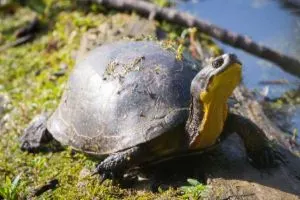
- Experience Level: Intermediate
- Family: Emydidae
- Scientific Name: Emydoidea Blandingii
- Other Names: N/A
- Adult Size: Between 5 and 8 inches
- Lifespan: Up to 80 years
- Average Price Range: Between $300 and $450
Also known as “the turtle that smiles”, Blanding’s turtles are named after naturalist William Blanding, these turtles have dark oval shells covered in yellow speckles. Their plastrons are yellow with black patches.
Blanding’s turtles seem to be doing relatively well in Nebraska. They are found across most of the central counties as well as a few eastern regions. It is illegal to capture native Blanding’s turtles.
Blanding’s turtles are omnivorous, mainly eating crayfish, earthworms, and water-borne invertebrates. They also occasionally eat plants, and unlike many other species of turtle do not rely on water to help them swallow.
2. Ornate Box Turtle
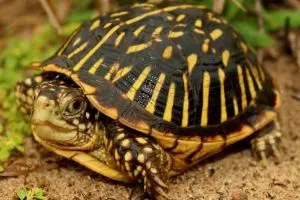
- Experience Level: Intermediate to Expert
- Family: Emydidae
- Scientific Name: Terrapine Ornata
- Other Names: Box Tortoise, Western Box Turtle
- Adult Size: Between 4 and 5 inches
- Lifespan: Up to 28 years in captivity, up to 40 years in the wild
- Average Price Range: Between $130 and $450
- Recommended Books: Box Turtles (Complete Herpcare) by Tess Cook
Specimens of this beautifully colored species have distinctive patterning on their domed shells, sporting a series of yellow to orange stripes. They are widespread across most of Nebraska, except for the areas around Lincoln.
These turtles are active during the day and forage for food, especially after rainfall. They prefer open habitats like grasslands or prairies, but have recently faced declines in populations due to habitat loss as well as being captured for sale.
Ornate Box turtles are omnivorous, mostly eating earthworms, insects, and occasionally carrion. They will also eat vegetation such as plants and fruits such as berries.
3. False Map Turtle
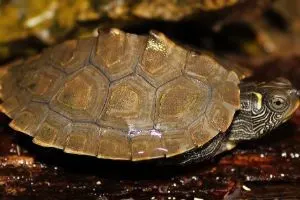
- Experience Level: Beginner
- Family: Emydidae
- Scientific Name: Graptemys pseudogeographica
- Other Names: N/A
- Adult Size: Between 3 ½ and 10 ½ inches
- Lifespan: Between 30 and 50 years
- Average Price Range: Between $6 and $40
- Where To Buy: turtlesource.com
- Recommended Books: Map Turtleand Sawback Atlas by by Peter V. Lindeman (Author), Anders G. J. Rhodin (Foreword)
False Map turtles are relatively scarce in Nebraska, mainly confined to the extreme eastern borders of the state. They prefer larger rivers and isolated ponds.
False Map turtles have dark shells, often brown or black and have contour-like yellow markings. As the turtle ages, this pattern gets fainter. Most adults have a pronounced keel on their backs.
To distinguish themselves from other Map turtles, False turtles lack colored patches and markings on their heads. They are omnivorous and rarely travel far from the water, and like to bask on outcrops over the water surface.
4. Yellow Mud Turtle
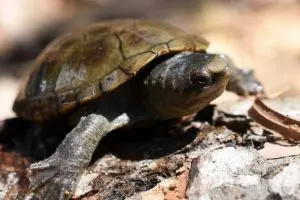
- Experience Level: Intermediate
- Family: Kinosternidae
- Scientific Name: Kinosternon Flavescens Flavescens
- Other Names: Yellow-necked Mud turtle
- Adult Size: Between 3 and 5 inches
- Lifespan: Between 10 and 40 years
- Average Price Range: Between $150 and $295
- Where To Buy: theturtlesource.com
Yellow Mud Turtles mainly dwell in marshes and ponds. They like to burrow and dig, often in sandy, muddy areas and also favor grasslands and prairies. They are uncommon in Nebraska, occurring in isolated pockets in south western and central western regions.
These small turtles have unmarked shells that are usually olive in color. They have some yellow coloring around their faces and also have yellow plastrons.
Yellow Mud turtles mainly eat crustaceans, aquatic invertebrates, earthworms, and mollusks. They can consume food either in the water or on land, but prefer to catch their prey in the water.
5. Western Painted Turtle
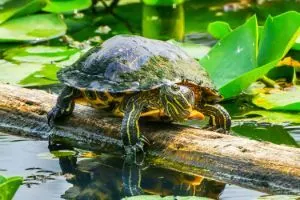
- Experience Level: Beginner
- Family: Emydidae
- Scientific Name: Chrysemys Picta Belli
- Other Names: N/A
- Adult Size: Between 4 and 10 inches
- Lifespan: Between 30 and 50 years
- Average Price Range: Between $20 and $50
- Recommended Books: Painted Turtle Pet Owners Guide by Ben Team
The largest of the Painted turtle subspecies, Western Painted turtles are common all across Nebraska. Western Painted turtles have darker patches on their plastrons than other Painted turtle subspecies, with dark to olive green shells.
Western Painted turtles sport a series of bold yellow stripes across their skin and face. They will inhabit virtually any body of water across Nebraska.
Mainly an aquatic species, Painted turtles stay near the water and like to bask. Painted turtles are omnivorous and mainly eat mollusks, frogs, and underwater invertebrates. They must swallow food in the water.
6. Red-eared Slider

- Experience Level: Beginner
- Family: Emydidae
- Scientific Name: Trachemys Scripta Elegans
- Other Names: Water Slider turtle, Red-eared Terrapin
- Adult Size: Between 6 and 8 inches
- Lifespan: Between 20 and 40 years
- Average Price Range: Between $15 and $50
A popular pet turtle species, Red-eared Sliders are semi-aquatic turtles. Nebraska represents the extreme edge of their native range, and they are only found in Nemaha and Richardson counties in Nebraska’s extreme southern regions.
Red-eared Sliders like to bask and often stack themselves upon each other and favor warm, slow-moving waters. As omnivores, they consume small fish, aquatic invertebrates, and underwater vegetation.
Red Eared Sliders commonly have an olive green shell, with yellowish striped markings on their scales. Their heads are usually a darker color, with yellow band markings and red patches just behind their eyes.
7. Common Snapping Turtle
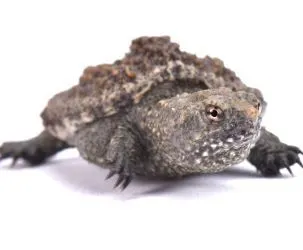
- Experience Level: Intermediate to Expert
- Family: Chelydridae
- Scientific Name: Chelydra Serpentina
- Other Names: Common Snapper, Eastern Snapping turtle, Snapper
- Adult Size: Between 8 and 20 inches
- Lifespan: Between 30 and 50 years
- Average Price Range: Between $20 and $40
- Recommended Books: Snapping Turtle Pet Owners Guide by Ben Team
Common Snapping turtles are a large, freshwater species that are widespread across Nebraska. They usually prefer larger bodies of water. They can be aggressive if cornered on land, and will often hiss and bite.
Common Snapping turtles are easily identified by their distinctive hooked overbites. They usually have dark brown or green ridged shells. They also have strong claws and long tails bearing saw-toothed spines.
As nocturnal omnivores, Common Snapping turtles mainly eat amphibians, fish and even smaller turtles. They have even been known to eat small waterbirds if they get close enough. Occasionally they will also eat plants.
8. Midland Smooth Softshell
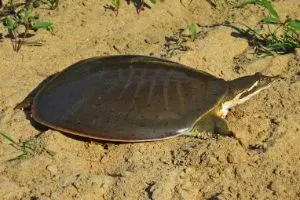
- Experience Level: Intermediate to Expert
- Family: Trionychidae
- Other Names: Spineless Softshell, Pancake turtle
- Scientific Name: Apalone Mutica Mutica
- Adult Size: 4 ½ to 7 inches for males, 6 ½ to 14 inches for females
- Lifespan: 25 years and over
- Average Price Range: Between $40 and $60
- Where To Buy: theturtlesource.com
- Recommended Books: Softshell Turtles Pet Owners Guide by Ben Team
A subspecies of the Smooth Softshell, Midland Smooth Softshells are native to the eastern half of Nebraska. They mainly inhabit larger rivers, preferring areas with large sand bars where they can bury themselves to ambush prey.
Midland Smooth Softshells resemble leathery pancakes, lacking hard carapaces. They are usually brown or gray, with lines running from behind their eyes and snouts. Their long necks enable them to snatch prey from their hiding place.
They are active during the day and bury themselves in sand in the shallows at night to sleep. They mainly eat water-borne insects, but also mollusks and crayfish.
9. Spiny Softshell Turtle
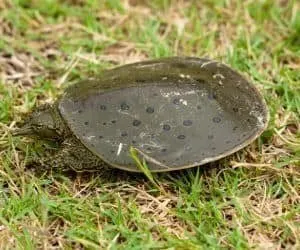
- Experience Level: Intermediate to Expert
- Family: Trionychidae
- Scientific Name: Apalone Spinifera
- Other Names:
- Adult Size: 5 to 9 ½ inches for males, 7 to 17 inches for females
- Lifespan: Between 20 and 50 years
- Average Price Range: Between $70 and $280
- Recommended Books: Softshell Turtles Pet Owners Guide by Ben Team
Spiny Softshell turtles are fast swimmers who typically favor rivers or streams with moving currents. They are found across much of Nebraska except for extreme north western counties.
Spiny Softshells have a leathery rough shell shaped like a pancake. Thanks to their delicate spines, their shells feel a bit like sandpaper. Their long, tapered beaks allow them to breathe while buried in the sand and awaiting prey.
These Softshells are carnivores and will feed on any crustaceans, insects, and mollusks that swim past their hiding place. With their long necks, they lash out and catch their prey.
Conclusion
In this list we have met the 9 species of native turtles in Nebraska. This diverse range of characters includes more common species such as the Common Snapping turtle as well as rarer specimens like the Yellow Mud turtle.
If you enjoyed this list, or are thinking of purchasing one of these species as a pet, don’t hesitate to comment below and discuss these turtles with other herpetology fans!
Other nearby states
